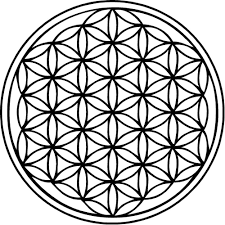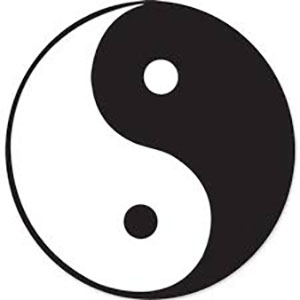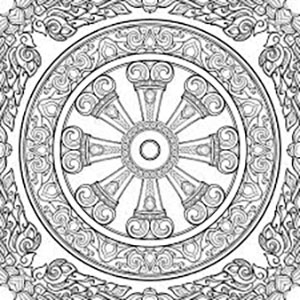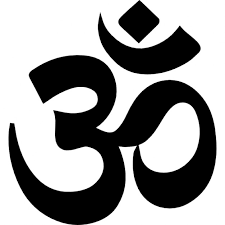When you embark on a yoga journey, you will be setting onto a spiritual path, as well as physical. Even if you don’t fully embrace it spiritually to begin with, as you carry on learning about yoga you will come across symbols that, like yoga itself, have developed across religions and civilisations for thousands of years.
Without expecting to cover their deepest meanings in just a few words, I created this short list as I think anyone interested in yoga and culture would benefit from at least learning to recognise the most common of these symbols.
The Flower of Life
 A symbol of sacred geometry, the Flower of Life is said to contain all of the patterns of creation within it, as it can represent the fundamental forms of space and time.
A symbol of sacred geometry, the Flower of Life is said to contain all of the patterns of creation within it, as it can represent the fundamental forms of space and time.
It is possibly the most ancient symbol on this list, perhaps used since the time of the Sumerians (the first civilisation in the world), and is found in nearly all major religions.
Composed of seven overlapping, evenly spaced circles, the figure forms a flower-like pattern that’s structured like a hexagon. As expansive creation continues, so do the interlocking rings. This symbol is found in all cultures on the planet and variations of it have been used to represent equations that define mathematics, music, religion, evolution, and medicine.
Hamsa
 The Hamsa originates from the Arabic and Hebrew cultures. In both languages, it is the word for ‘five’, as in representing the five digits of the hand. The symbol is palm-shaped with an eye in the middle of the palm.
The Hamsa originates from the Arabic and Hebrew cultures. In both languages, it is the word for ‘five’, as in representing the five digits of the hand. The symbol is palm-shaped with an eye in the middle of the palm.
The Hamsa is known as the universal sign of protection and is used to ward off anyone who aims to cause you harm through the “evil eye” – we like to think of it as protection from negative intent.
Many religions have appropriated this symbol in some form, including Christianity, Islam, Buddhism, and Hinduism.
Yin Yang
 Used extensively in Chinese teachings, this symbol represents the harmony of the universe. All duality – like dark or light, masculine or feminine – needs balance. It’s said that balance between the two opposing forces of Yin and Yang brings the most harmony to an individual’s life.
Used extensively in Chinese teachings, this symbol represents the harmony of the universe. All duality – like dark or light, masculine or feminine – needs balance. It’s said that balance between the two opposing forces of Yin and Yang brings the most harmony to an individual’s life.
Yin is receptive, passive, cold, feminine energy. Yang is masculine, movement, force and heat. The dark and light represent knowledge and ignorance. In seeing the opposites, it is noted that each has a little of the other: in nature, there would not be light without dark, good without evil, male without female.
Dharma Wheel
 The Wheel of Dharma is the Buddhist spiritual symbol for teachings of the path of Nirvana. Each spoke represents a step in Buddha’s Eightfold Path.
The Wheel of Dharma is the Buddhist spiritual symbol for teachings of the path of Nirvana. Each spoke represents a step in Buddha’s Eightfold Path.
The paths are, right view, right intention, right speech, right action, right livelihood, right effort, right mindfulness, and right concentration. The circle represents the perfection of the teachings of dharma.
Lotus Flower
 Used in various eastern religions, the lotus is widely regarded as a representation of enlightenment, harmony, spiritual illumination and unlimited potential.
Used in various eastern religions, the lotus is widely regarded as a representation of enlightenment, harmony, spiritual illumination and unlimited potential.
The lotus flower rises from the sludge of muddy waters, which reinforces the concept of resurrection. This is the ultimate trajectory of humanity and shows that any trial can be overcome through perseverance. This symbol represents the journey out of darkness and into transformation.
Om
 Om is the mother of all mantras, and the primordial sound by which the universe was created. Used in Hinduism since its inception, Om could be considered the primary spiritual symbol of this religion. Om, or Aum is made up of three Sanskrit letters, a, u and m. The syllables come together to make the sound, Om, meaning Brahman, the supreme God of Hinduism.
Om is the mother of all mantras, and the primordial sound by which the universe was created. Used in Hinduism since its inception, Om could be considered the primary spiritual symbol of this religion. Om, or Aum is made up of three Sanskrit letters, a, u and m. The syllables come together to make the sound, Om, meaning Brahman, the supreme God of Hinduism.
The past, present and future are all blended in this one all-inclusive sound. When chanted, Om or Aum frees the consciousness to remember its natural state of connection to infinite source energy or Creation. By using this image, the concept of infinite love and creation is conveyed beyond the limitation of words or ideas.


Recent Comments